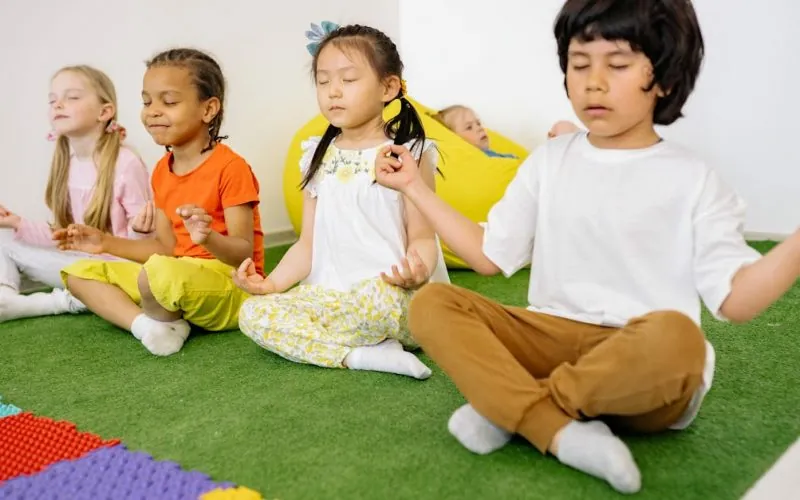Table of Contents
ToggleHigh school can feel like a whirlwind of homework, exams, and social drama. Amidst all the chaos, students often forget to take a breather. Enter mindfulness activities, the secret sauce for surviving those teenage years with sanity intact. Who knew that pausing to breathe could be more refreshing than a double shot of espresso?
Understanding Mindfulness
Mindfulness involves focusing on the present moment with acceptance. It encourages individuals to observe thoughts and feelings without judgment, fostering a sense of awareness.
Definition of Mindfulness
Mindfulness refers to the practice of paying attention deliberately to thoughts, emotions, and bodily sensations in the moment. It helps individuals recognize patterns and triggers without getting overwhelmed. Techniques often include breath awareness, meditation, and guided imagery. Practicing mindfulness can lead to clarity and a greater sense of connection with one’s own experiences.
Importance of Mindfulness for Students
Mindfulness plays a crucial role in reducing stress among students. Research indicates that practicing mindfulness can enhance focus and improve emotional regulation. Skill development includes concentration and resilience, which are vital during the demanding high school years. Increased self-awareness can lead to better decision-making and reduced anxiety, enabling students to navigate academic and social pressures effectively.
Benefits of Mindfulness Activities for High School Students
Mindfulness activities provide various advantages for high school students. Engaging in these practices fosters important skills essential for academic and personal success.
Improved Focus and Concentration
Practicing mindfulness directly enhances focus and concentration. Students often find that dedicating time to mindful breathing or meditation strengthens their attention spans. Techniques like body scans or mindful observation refine their ability to remain present during lessons. When attention shifts away, mindfulness encourages students to gently redirect their focus back to tasks at hand. Consistent practice results in a noticeable increase in academic performance, as students become more engaged in their studies and classroom discussions.
Reduced Stress and Anxiety
Mindfulness activities significantly decrease stress and anxiety levels in high school students. These practices facilitate relaxation, allowing students to release tension accumulated from academic pressures and social situations. Deep breathing exercises, for instance, cultivate calmness and clarity during overwhelming moments. Students report feeling more grounded and better equipped to handle challenges when they regularly practice mindfulness. As a result, they experience improved emotional regulation, leading to higher overall well-being.
Effective Mindfulness Activities for High School Students
High school students can benefit greatly from mindfulness activities. These practices encourage relaxation and enhance focus, making them ideal during stressful times.
Breathing Exercises
Breathing exercises allow students to center themselves quickly. Practicing deep breathing fosters a sense of calm and clarity. Techniques such as the 4-7-8 method involve inhaling for four seconds, holding for seven, and exhaling for eight. These simple steps reduce anxiety and promote a healthier mindset. Incorporating a few minutes of mindful breathing at the start of a class or study session can improve concentration and performance.
Guided Meditation
Guided meditation creates a structured environment for students to explore mindfulness. Using audio or video resources, instructors can lead students through visualization exercises. Sessions typically last from five to twenty minutes, allowing participants to connect with their feelings and thoughts. Focusing on relaxing imagery encourages overall stress relief and emotional balance. Students can practice guided meditation either as a group or individually, integrating it into their daily routines.
Journaling Practices
Journaling practices help students process their thoughts and emotions effectively. Writing daily reflections can clarify feelings and build self-awareness. Setting aside time for journaling fosters a habit of introspection and encourages personal growth. Prompting questions, such as “What am I grateful for today?” or “What challenges did I face?” guides the writing process. Over time, students experience enhanced emotional regulation and improved coping skills through consistent journaling.
Implementing Mindfulness in High School Settings
Integrating mindfulness into high school routines enhances student well-being and academic performance. Creating consistent practices fosters a sense of calm amidst chaotic schedules.
Creating a Mindfulness Routine
Establishing a mindfulness routine requires intentional planning. Start with short, five-minute sessions for daily mindful breathing exercises. Set a specific time each day to help students form this habit. Incorporating mindfulness into existing classes provides a natural flow to the routine. Teachers can initiate sessions before tests or challenging lessons. Consistency strengthens the habit, making mindfulness a valued part of students’ daily lives.
Engaging Students in Activities
Engaging students in mindfulness activities involves creativity and inclusivity. Consider using varied techniques such as yoga, art therapy, or nature walks. Organizing group activities fosters a sense of community while practicing mindfulness. Encourage students to share experiences and reflect on their feelings. Integrating technology, like mindfulness apps or guided meditation videos, caters to tech-savvy students. Making mindfulness relatable enhances participation, ensuring students understand its relevance for managing stress and improving focus.
Mindfulness activities provide high school students with essential tools to navigate the complexities of their academic and social lives. By embracing practices like mindful breathing and journaling, students can cultivate a greater sense of awareness and emotional balance. These techniques not only help in reducing stress but also enhance focus and resilience.
Incorporating mindfulness into daily routines fosters a supportive environment where students can thrive. As they learn to manage their thoughts and feelings, they become better equipped to face challenges head-on. By prioritizing mindfulness, students can unlock their potential and promote overall well-being, setting the stage for future success.




